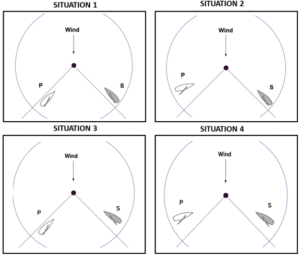“On a beat to windward” has been urgently redefined effective 3 December 2018 by World Sailing.
18 MARK-ROOM
18.1 When Rule 18 Applies
Rule 18 applies between boats when they are required to leave a mark on the same side and at least one of them is in the zone. However, it does not apply
- between boats on opposite tacks on a beat to windward,
- between boats on opposite tacks when the proper course at the mark for one but not both of them is to tack.
- between a boat approaching a mark and one leaving it, or
- if the mark is a continuing obstruction, in which case rule 19 applies.
The case on when a boat is on a beat to windward (when mark room does not apply) has been redefined to accord with the way that sailors think it should work. Here is an excerpt from the revised case.
For the purpose of rule 18.1(a), which is only needed in multi-boat situations when at least one boat is in the zone, two boats on opposite tacks are considered to be ‘on a beat to windward’
(1) when the proper course for each of them is close-hauled or above, or
(2) when one or both of them have overstood the close-hauled layline to the mark and are sailing below close-hauled.
Consider the following four situations, each involving boats on opposite tacks in the zone of a mark to be left to port. The mark could be a windward mark, a finishing mark at the port end of a finishing line, a windward gate mark, or a limit mark that is not a rounding mark. In each of these situations, the boats shown are ‘on opposite tacks on a beat to windward’ and, therefore, rule 18 does not apply between them.

In situations 2, 3 and 4 if the boats were not on a beat to windward then the mark room rule would apply and the port tack boat would be entitled to mark room – That would be scary!
Don’t forget that even though mark-room does not apply in these scenarios, when the port tack boat passes head to wind, rule 18 is applied, in particular rule 18.3 – Tacking in the zone.
For dinghy and foiling sailors, note that the definition is different as regards rule 42. Read the full case here












